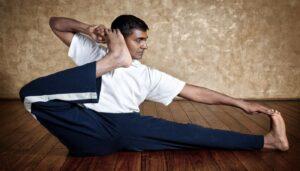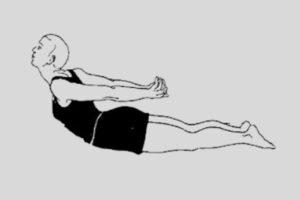Best Yoga Asanas for Tight Hamstrings
Are you looking for techniques to improve your hamstring flexibility and feel better physically? Look nowhere else! In this article, we’ll dig into the realm of yoga and examine seven potent postures made just for hamstring strengthening. You may improve your flexibility, reduce muscular tension, and develop a stronger, more balanced body by including these postures into your daily yoga practise. Roll out your yoga mat and join us as we explore the “Best Yoga Poses for Tight Hamstrings” and their transforming journey.
Why Is Hamstring Flexibility Important?
Hamstring flexibility is essential to our overall physical health and wellbeing. Many factors make hamstring flexibility crucial, including these ones:
1. Increased Performance: By lengthening strides, enabling more mobility, and lowering the risk of injuries, flexible hamstrings improve athletic performance.
2. Postural Alignment: Tight hamstrings can contribute to bad posture, which strains the lower back and may result in pain or discomfort.
3. Increased Range of Motion: Having flexible hamstrings makes it easier for us to move about and accomplish daily tasks with ease.
4. Injury Prevention: By absorbing impact and lowering the strain on nearby muscles and joints, strong hamstrings assist avoid strains and tears.
Understanding the Hamstrings: A Closer Look
Let’s take a minute to discuss the hamstrings and their function in our body mechanics before moving on to the yoga poses.
The biceps femoris, semitendinosus, and semimembranosus make up the hamstrings. These muscles link the sit bones to the lower leg around the back of the thigh. They are essential for flexing the knee joint and stretching the hip joint.
Preparing for Your Yoga Practice: Warm-Up Exercises
Warming up is essential before beginning the trip to hamstring flexibility. You can add the following warm-up activities to your routine:
1. Cat-Cow: Start on all fours, arching your back upward (like a cat) and lowering your belly downward (like a cow) (like a cow). The spine heats up from this mild movement, which also heightens body awareness.
2. Sun Salutations: Do a few rounds of these stretches to warm up your hamstrings as well as the rest of your body. These dynamic exercises get your muscles ready for longer stretches.
Pose 1: Forward Fold (Uttanasana)
Forward Fold, often referred to as Uttanasana, is one of the fundamental positions for hamstring flexibility. This position encourages muscular relaxation and lengthening by stretching the hamstrings, calves, and lower back. How to do the Forward Fold:
With your feet hip-width apart and your arms at your sides, take a tall stance.
Deep exhale, then slowly bend forward from the hips while maintaining a long spine.
Place your hands on the floor or grip the elbows on each side of you for a deeper stretch while you let your upper body dangle over your legs.
Protect your lower back by contracting your quadriceps and gently activating your core.
Maintain the position for 30 to 60 seconds while taking the stretch in stride.
Engage your core as you gently roll up, stacking one vertebra at a time, until you are back in a standing posture to release the pose.
Pose 2: Downward-Facing Dog (Adho Mukha Svanasana)
Yoga’s well-known downward-facing dog posture has several advantages, including improving hamstring flexibility. In addition to giving the body a moderate inversion, it also strengthens the arms, shoulders, and core. Downward-Facing Dog Exercise:
Begin by getting down on all fours, your knees apart, and your hands shoulder-width apart.
Lifting your knees off the ground, tuck your toes beneath and grip your hands firmly.
Extend your tailbone upward and straighten your legs, if necessary maintaining a small bend in the knees.
Spread your fingers wide for support as you firmly press your hands into the mat.
To stretch your hamstrings, contract your quadriceps and lower your heels to the floor.
With your attention on stretching your spine and relaxing your neck, hold the position for 5 to 10 breaths.
When you’re ready to relax, softly squat down into Child’s Pose.
Pose 3: Standing Forward Bend (Uttanasana)
Another good posture for hamstring flexibility is the standing forward bend, which gives the backs of the legs a deep stretch and enhances blood flow. To practise a Standing Forward Bend, follow these steps:
With your feet hip-width apart and your hands on your hips, take a tall stance.
Deep inhalations extend the spine. When you exhale, tilt forward from the hips.
Fold forward, leading with your chest, keeping your back straight.
To gently sway, let your hands fall to the floor or grip the elbows on each side of you.
If necessary, flex your knees, and concentrate on stretching the backs of your legs.
Hold the position for 30 to 60 seconds while taking deep breaths.
Engage your core and take a deep breath as you gently climb back up to a standing posture to exit the pose.
Pose 4: Triangle Pose (Trikonasana)
Hamstrings, hips, and side bodies are stretched in the triangle Pose, a standing posture. Moreover, it fosters a sense of groundedness while enhancing balance and stability. Triangle Pose instruction is as follows:
Start off with your feet approximately three to four feet apart in a wide-legged posture.
Align your right heel with your left foot’s arch by extending your right foot outward by 90 degrees.
With your hands down, extend your arms parallel to the ground.
Take a deep breath in, extend your right arm forward as you exhale, and maintain your body long as you hinge at the hip.
Depending on your flexibility, lower your right hand to the floor, your ankle, or your shin. Straighten out your left arm and raise it up towards the sky.
Choose a posture for your neck that is comfortable and look up or straight ahead.
To initiate the hamstring stretch, press through your feet and tense your thighs.
Maintain the position for 30 to 60 seconds while inhaling deeply and keeping your balance.
Inhale as you rise your body and return your arms to the beginning position to release. On the opposite side, repeat.
Pose 5: Wide-Legged Forward Fold (Prasarita Padottanasana)
A potent position for hamstring flexibility that also works the inner thighs and hips is the wide-legged forward fold. It offers a substantial stretch while enhancing balance and fortifying the legs. To do the Wide-Legged Forward Fold, adhere to these steps:
Toes pointed forward, place your feet wider than hip-width apart.
Deep inhalations extend the spine. When you exhale, tilt forward from the hips.
For support, either bring your hands to the ground between your legs or place them on your hips.
Activate your quadriceps and firmly plant your heels into the mat.
Relax your neck and shoulders by letting your head droop.
Deeply inhale and keep the position for 30–1 minute.
Engage your core and take a deep breath as you gently climb back up to a standing posture to exit the pose.
Pose 6: Reclining Hand-to-Big-Toe Pose (Supta Padangusthasana)
The Hand-to-Big-Toe Position, performed while lying down, is a simple yet effective pose for hamstring flexibility. It supports the neck and back while enabling a deep stretch. How to Do the Reclining Hands to Big Toe Pose:
Your legs should be outstretched as you lay backward.
Hug your right knee into your chest as it is bent.
Wrap your right foot’s ball with a towel or a yoga strap.
Holding on to the strap with both hands, extend your right leg upward.
Maintain your left leg straight on the mat or, for added stability, bend the knee and plant the foot on the ground.
Straighten your back and relax your shoulders.
Be careful not to strain as you gently pull the strap to intensify the stretch in your hamstring.
Maintain the position for 30 to 60 seconds while taking slow breaths and letting your body unwind.
Return to the beginning position by releasing the strap and bending your right knee. On the opposite side, repeat.
Pose 7: Seated Forward Bend (Paschimottanasana)
A traditional posture that focuses on the hamstrings, lower back, and shoulders is the forward bend while seated. It encourages rest, improves digestion, and quiets the mind. How to perform a Sitting Forward Bend is as follows:
Your spine should be tall when you sit on the mat with your legs out in front of you.
Take a big breath in, and as you exhale, bend forward from the hips, moving your chest forward.
Reaching towards your ankles or feet, rest your hands there if it is more comfortable for you.
Avoid curving your back and maintain a long spine. To make your hamstrings stretch, contract your quadriceps.
Breathe deeply and slowly and allow your body to settle into the posture.
If you can’t reach your feet, you can help yourself by wrapping a strap or cloth over the bottoms of your feet.
Maintain the position for 30 to 60 seconds while taking the stretch in stride.
When you’re ready to exhale, tighten your abdominal muscles and gently return to a sitting posture.
FAQs: Common Questions About Hamstring Flexibility
To noticeably increase hamstring flexibility, it is advised to perform these poses at least three times a week. Key is consistency.
Before attempting these positions while pregnant, it is advised that you speak with your healthcare physician. They can offer advice on adaptations or suggest certain pregnant yoga poses that are secure for you and your unborn child.
Increasing hamstring flexibility takes different amounts of time depending on the individual. It relies on several elements including your present degree of flexibility, the constancy of your practise, and the peculiarities of your body. You should eventually observe advancements with consistent practise.
It’s crucial to pay attention to your body and avoid making any forced motions. With the stretches, try to avoid jumping or jerking to prevent injury. As your flexibility increases, start with mild stretches and progressively increase the intensity.
Before attempting these postures if you have a hamstring injury, it is recommended to speak with a doctor or a certified yoga instructor. They can advise you on adjustments or safe alternate positions for your condition.
Absolutely, novices can perform these positions. Therefore, it’s crucial to practice with correct alignment and make adjustments as necessary. Consider enrolling in a beginner’s yoga class or asking an experienced instructor for advice if you are new to yoga.
Conclusion
Your general physical well-being can be significantly improved if you regularly practise the seven yoga positions for hamstring flexibility. While you practise, keep in mind to be patient and give your body time to progressively gain more flexibility. Achieving the best results requires a combination of consistency, appropriate alignment, and listening to your body.
Get more flexible by releasing the strength of your hamstrings, and feel the freedom and relaxation that come with it. Roll out your yoga mat, take a deep breath, and start with the “7 Yoga Asana for Hamstring Flexibility” to begin your path of self-discovery. Accept the potential you possess and experience the delight a strong, flexible body can provide.
Learn to Know More So You Can Visit Best Yoga Teacher Training School in India and Join 200 Hour Yoga Teacher Training in India and 300 Hour Yoga Teacher Training in India and Ayurveda Yoga Teacher Training in India and Kundalini Yoga Teacher Training in India and Aerial Yoga Teacher Training in India




